Different Iris Flower Types
Irises are perennial flowers that are extremely popular garden flowers that come in a number of varieties and colors. Although there are many different types of irises, all Irises can be divided into two distinct categories – bulbs and rhizomes.
Bulb irises tend to have some of the most popular varieties of irises. These irises are somewhat smaller than the other category of irises, the rhizome irises and are also somewhat easier to grow.
Bulb irises are normally planted in the fall and bloom in the spring.
Rhizome irises grow from planting sideway stems. While they are not terribly difficult to grow these flowers, some beginners find growing rhizome irises a bit challenging and should begin their iris growing with irises in the bulb category.
Rhizome irises tend to be planted in the spring and often bloom in the same year.

Related Articles:
- 8 Different Types of Peonies
- 13 Different Types of Dianthus
- 7 Different Types of Dahlias
- 10 Enchanting Orchid Varieties
Now that we’ve looked at the two different categories of irises here are a few of the more popular types of both bulb and rhizome irises.
7 Different Types of Irises (Iris Varieties)
#1. Dutch Irises (Bulb)
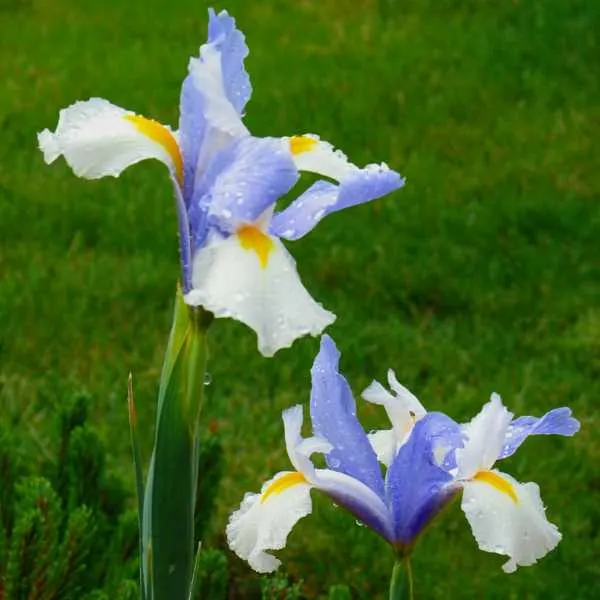
Dutch irises are the most common type of bulb iris and one of the easiest to grow. The bulbs for these flowers are planted in the fall and the flowers bloom in the spring.
These irises are multicolored with combinations normally being blue, bluish/purple, white, bronze, gold, rose and yellow. They are slow growing and short lived.
Dutch Irises originated in Europe and here in the United States they grow best in zones 5 through 9. They prefer full sun and moist well-drained soil and can reach a height of 1 ½ to 2 feet tall.
Varieties of Dutch Irises include Blue Major, White Excelsior, Yellow Queen, Apollo and Spanish Iris.
#2. Reticulata or Netted Irises
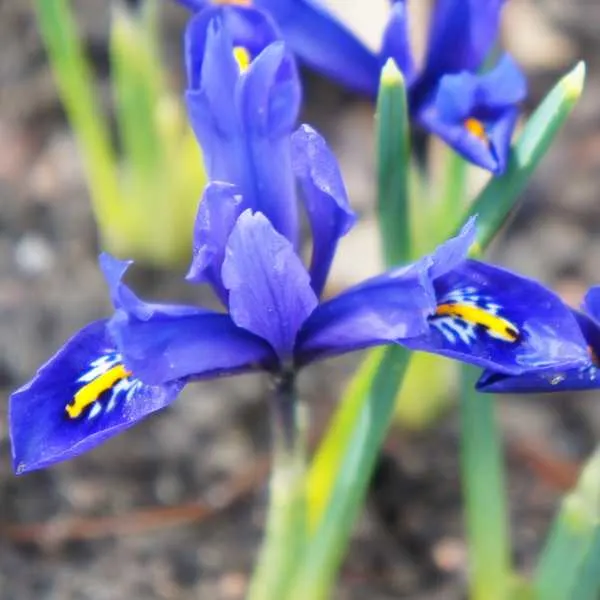
The Iris Reticulata is a bulb iris that is sometimes referred to as a netted iris because the bulb has some type of netting around it. They need to be planted in the fall for early spring blooming.
This dwarf flower is blue or purple in color with yellow details on the petals. Each flower is made up of 3 upright petals and 3 drooping petals (called falls) and it has thin grass-like foliage.
These flowers grow to be between 4 and 6 inches tall making them perfect for borders and rock gardens.
They grow best in zones 5 through 9 and prefer full to partial sun and loamy or sandy soil.
Native to Europe, Asia or the Middle East these flowers are toxic to people or pets.
Examples of Reticulata irises include Irish Harmony, Katherine Hodgkin, Lady Beatrice Stanley and Angel Tears.
#3. Bearded Irises
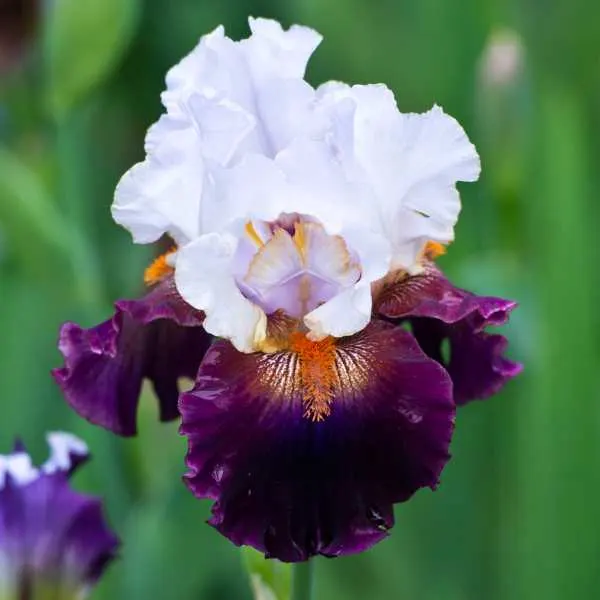
Bearded Irises are the most popular of all rhizome irises. This flower needs to be planted in the spring from nursery starts and will normally flower the first year.
They come in a wide variety of colors including red, yellow, purple, white, blue, pink and brown. They may also be bicolor.
Bearded irises get their name because of the soft bristles on the drooping petals.
These irises grow best in zones 3 through 9 and prefer to grow in full sun and well-draining soil. Bearded irises depending on the variety can bloom anywhere from early spring to early summer and grow to be 12 to 20 inches tall.
Examples of bearded irises include Beverley Sills, Hello Darkness, and Jesse’s song, Stairway to Heaven and Queen’s circle.
#4. Crested Irises
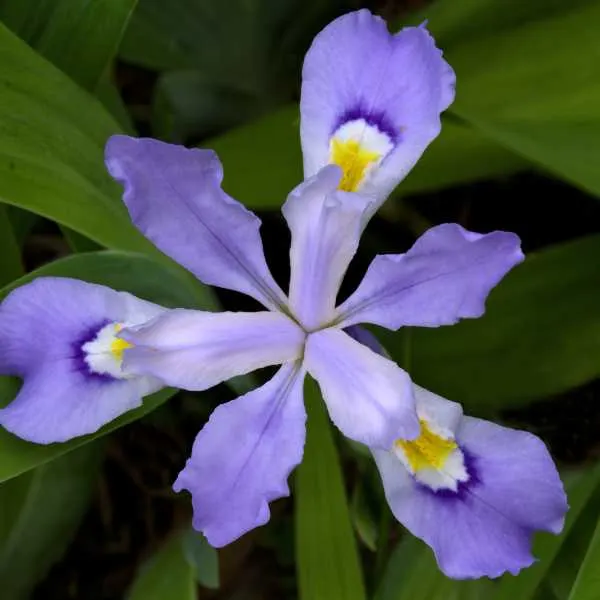
The crested iris is a spring blooming dwarf flower grown from a rhizome. These irises feature sword-like bright green leaves and several violet-blue flowers with white splotches and a golden crest.
These flowers grow best in zones 4 through 10 and prefer partial sun and clay or loamy well-drained soil. Crested Irises grow to be 6 to 9 inches tall and are perfect for borders and rock gardens.
Native to the Southeast United States these flowers are drought and deer resistant and toxic to dogs, cats and horses.
#5. Yellow Flag Iris
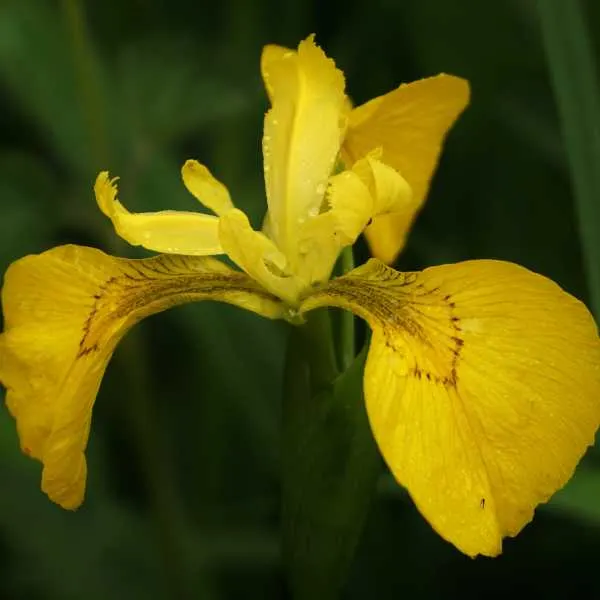
The Yellow Flag iris is an easy to grow and low maintenance flower grown from rhizomes.
This iris prefers to grow in wet areas so they make great flowers to plant near ponds or in swampy areas. Yellow Flag Irises are bright yellow in color and has greenish/gray foliage.
This plant grows best in zones 5 through 9 and prefers full or partial sun and loamy or clayey extremely damp soil. The flowers reach a height of about 3 feet tall.
Native to Europe, Africa and Asia these irises are toxic to dogs, cats and horses as well as humans.
#6. Japanese Irises
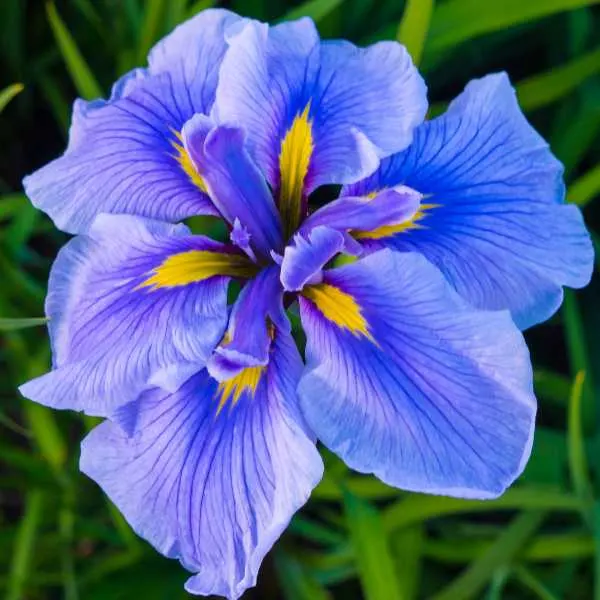
Japanese irises grow from bulbs that are planted in the fall and bloom in the late spring or summer.
These irises feature flowers that measure 3 to 6 inches across and may be lavender, blue, white or pink with green blade like foliage.
Japanese irises grow best in zones 4 through 9 and prefers full or partial shade and rich constantly damp soil. Hence these irises are great for planting around ponds or boggy areas where many other plants simply can’t grow.
These irises grow between 2 and 4 feet tall and are toxic to humans and animals.
#7. Siberian Iris

Siberian irises grow from rhizomes and are a beardless type of iris with the typical iris shape of three upright petals and 3 falls.
Although normally bluish-purple in color these flowers may also be red, white, pink, yellow and bicolor.
Each flower features a branched stem on which up to 5 flowers grow. The foliage is thin and strappy and lasts long after the flowers stop blooming giving the foliage the look of ornamental grass.
This iris is more cold hardy than other irises and can be grown in zones 3 through 8. It prefers full or partial sun and moist well-drained soil (although it is somewhat drought tolerant)
The Siberian irises grow to be between 2 ½ and 4 feet tall. They originated in Europe and Asia and they are slightly toxic to humans and pets.
Final Thoughts on the Different Kinds of Irises
Looking at the various varieties of Irises it is easy to see why these flowers are popular in the eyes of both beginner and seasoned flower gardeners.

